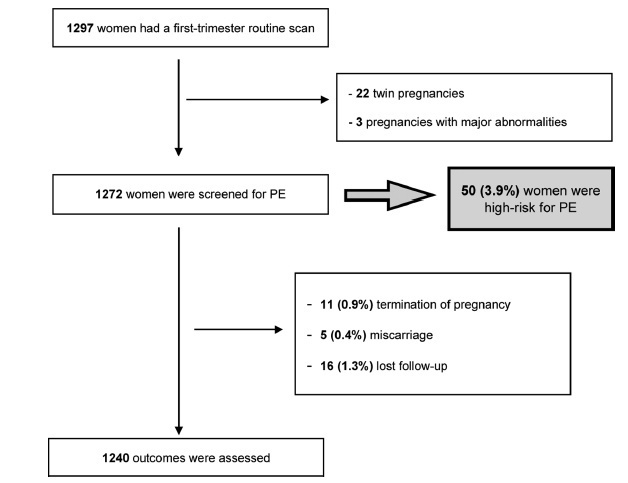Revista Brasileira de Ginecologia e Obstetrícia. 2020;42(7):390-396

Preeclampsia is a major cause of perinatal and maternal morbidity and mortality. Our objective is to assess the performance of a combined screening test for preeclampsia in the first trimester and the prophylactic use of low-dose aspirin.
Prospective study of all women attending our hospital for the first-trimester screening of aneuploidies, between March 2017 and February 2018 (n = 1,297). The exclusion criteria weremultiple pregnancy andmajor fetal abnormalities. Preeclampsia screening was performed with an algorithm that includes maternal characteristics, and biophysical and biochemical biomarkers. High-risk was defined as a risk ≥ 1:50 of earlyonset preeclampsia (before 34 weeks), in which cases low-dose aspirin (150mg at night) was offered to these women from screening until 36 weeks.
From the 1,272 enrolled participants, the majority were Caucasian (1,051; 82.6%) and multiparous (658, 51.7%). Fifty patients (3.9%) screened high-risk for preeclampsia, and all started a low-dose aspirin regimen, with good compliance (96%). Early-onset preeclampsia was found in 3 pregnant women (0.24%), and total preeclampsia was diagnosed in 25 (2.02%), compared with 28 (0.75%) cases of early preeclampsia (p = 0.0099) and 98 (2.62%) of total preeclampsia (p = 0.2904) before the implementation of screening.
There was a lower incidence of both, early-onset and total preeclampsia, after the introduction of universal screening and prophylactic use of low-dose aspirin. This reduction was statistically significant in early-onset preeclampsia. The association of a first-trimester combined screening model and aspirin prophylaxis appears to be useful in predicting and reducing the incidence of early-onset preeclampsia, in a routine care setting.
Search
Search in:


Comments